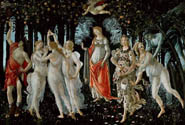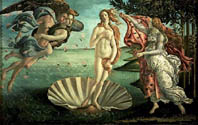Sandro Filipepi, known as Botticelli, was born in Florence in 1445. He trained with Filippo Lippi; the influence of this artist is visible in one of Botticelli’s early works: the Madonna with Child (Capodimonte Museum, Naples). Botticelli was influenced by Pollaiolo’s art as well. This can be seen in works such as the Fortress and St Sebastian. Lines are used carefully here and the graphic motive is more important than the colour or realistic impression.
art as well. This can be seen in works such as the Fortress and St Sebastian. Lines are used carefully here and the graphic motive is more important than the colour or realistic impression.
This style can be seen in other works from his early years. He painted Primavera for Lorenzo di Piero de' Medici. In this painting the central figure, Venus, is between two groups of figures: on one side Zephyrus chases Flora and spring, clad in flowers; on the other side are the three Graces and Mercury. Botticelli achieved perfect harmony between the linear rhythm of the drawing and the life-like representation of shapes. The light is weak and evanescent. The same atmosphere and use of light cold colours can be seen in the Birth of Venus, painted between 1482 and 1484, as well as other paintings such as Pallas and the Centaur and Mars and Venus. In these years he also painted holy subjects, such as the Madonna Magnificat and the Madonna of the pomegranate.
holy subjects, such as the Madonna Magnificat and the Madonna of the pomegranate.
Between painting his masterpieces, the Primavera and the Birth of Venus, Botticelli was in Rome and he worked with Cosimo Rosselli, Ghirlandaio and Perugino, on some frescos in the Sistine Chapel. He painted the Punishment of Korah, and scenes from the Temptation of Moses and the Temptation of Christ.
At the end of the century his style changed considerably: he painted more holy and religious scenes, possibly influenced by Savonarola. All his shapes had a hard edge to them, colours became darker and his figures became more pathetic than they had been. His compositions were more dynamic but the abstract trait of his previous production is still visible.
In 1495 he painted Calunnia (Libel): there is a lot of movement in this painting and the architecture is very sumptuous.
Other works from this period are: Nativity, the Pietà, Annunciation. His new painting style can be seen in these works; there is high spiritual tension and the shapes are made to look old.
Botticelli died in Florence in 1510.